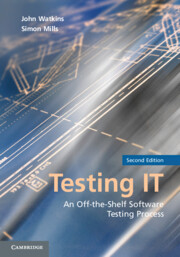Book contents
- Frontmatter
- Contents
- Foreword to the Second Edition by Geoff Thompson
- Foreword to the First Edition by Maurice Rosenburgh
- Acknowledgments
- 1 Introduction
- PART 1 THE TRADITIONAL TESTING PROCESS
- PART 2 THE TESTING PROCESS IN THE REAL WORLD: ILLUSTRATIVE CASE STUDIES
- PART 3 THE APPENDICES
- References
- Glossary
- Index
Foreword to the First Edition by Maurice Rosenburgh
Published online by Cambridge University Press: 03 May 2011
- Frontmatter
- Contents
- Foreword to the Second Edition by Geoff Thompson
- Foreword to the First Edition by Maurice Rosenburgh
- Acknowledgments
- 1 Introduction
- PART 1 THE TRADITIONAL TESTING PROCESS
- PART 2 THE TESTING PROCESS IN THE REAL WORLD: ILLUSTRATIVE CASE STUDIES
- PART 3 THE APPENDICES
- References
- Glossary
- Index
Summary
Why is astronomy considered a science while astrology is considered only a pseudoscience? In other words, how can we prove that a theory faithfully describes reality, and that this theory can then be used to predict unknown facts? Karl Popper, the well-known philosopher, studied these problems and summarized his conclusions in one phrase: “The criterion of the scientific status of a theory is its falsability, or refutability, or testability.” For Popper, “confirming evidence should not count except when it is the result of a genuine test of the theory.”
The testing process of a scientific theory is quite similar to the process of providing confirmation either to risky predictions or to attempts to falsify that theory. Testing is a complex activity. It has to simultaneously bear in mind the theory and the external reality; it has to provide objective answers to complex questions related to our own perceptions of a rational reality.
When developing software, we follow the same thought process, since one builds an abstract model between the external world and the user. In our software, we define strict processes that will guide our actions, and we build the data we want to manipulate in complex databases and templates.
- Type
- Chapter
- Information
- Testing ITAn Off-the-Shelf Software Testing Process, pp. xv - xviPublisher: Cambridge University PressPrint publication year: 2010



